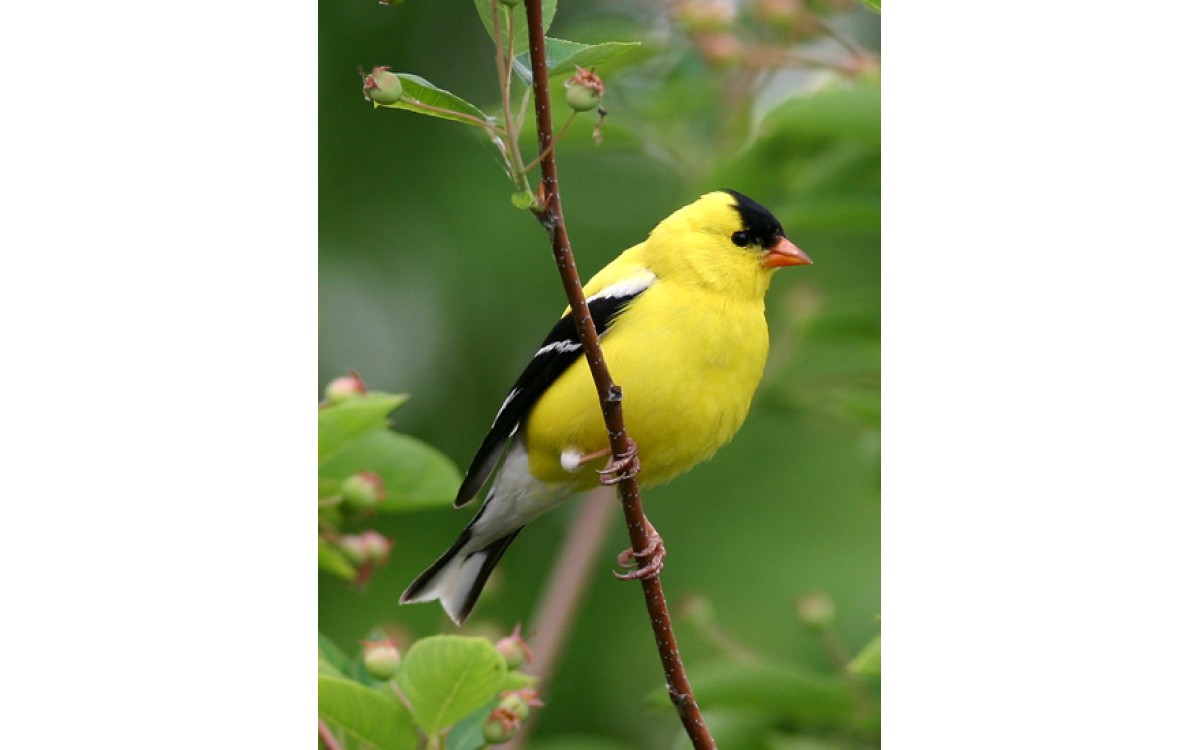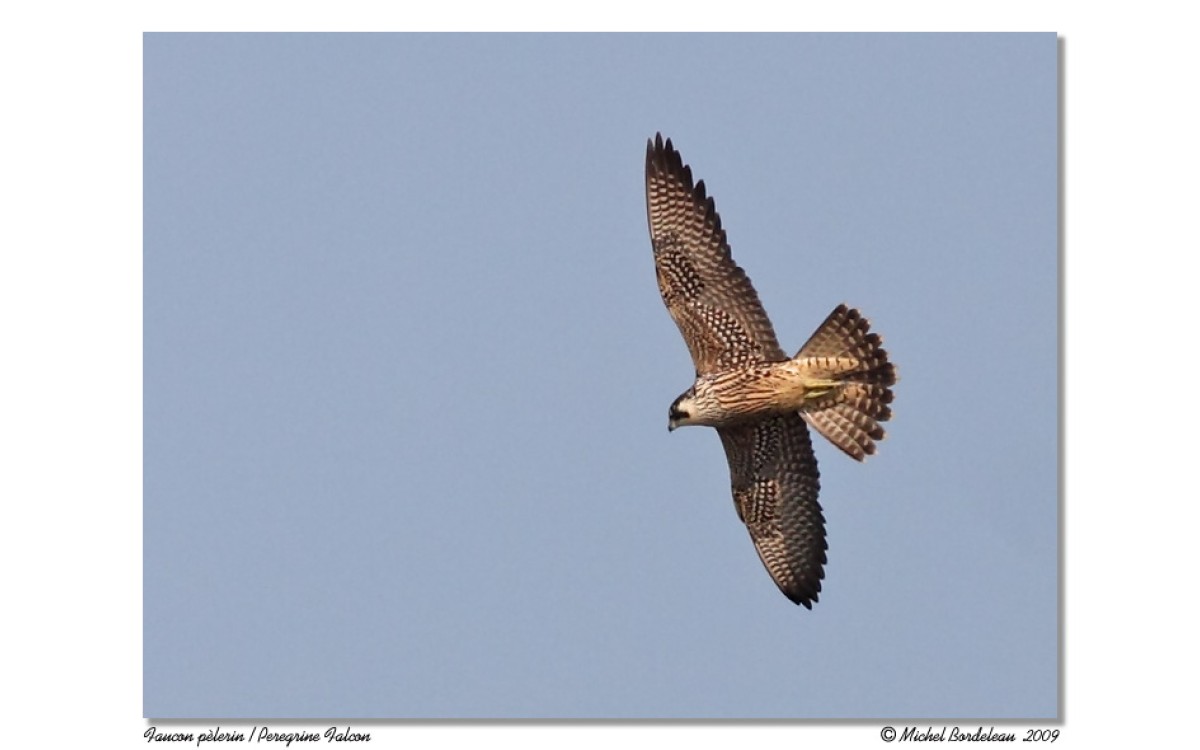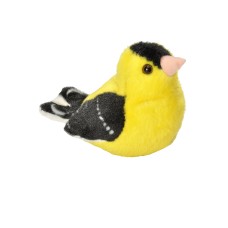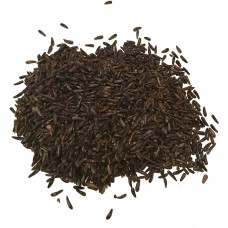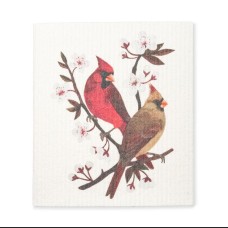The American Goldfinch (Spinus tristis) is a small bird with a beautiful song, easily recognizable by its bright yellow plumage during the summer.
The Goldfinch is partially migratory.
It stays generally year-round in northern and central United States and migrates to southern Canada during the summer.
In winter, it can be found throughout much of the United States and in parts of Mexico. A few American Goldfinches may still be observed in southern Quebec during the colder months.
These birds thrive in open spaces such as along roads, at the edge of forests, or in trees in open areas.
It is primarily granivorous, although they occasionally eat insects and berries.
In the wild, the American Goldfinch feeds on seeds from plants like thistle, dandelion, sunflower, cosmos, and ragweed. At bird feeders, it mainly prefers nyjer and sunflower seeds. It is adaptable to almost any type of feeder, and can often be seen feeding on the ground under feeders.
The Goldfinch is agile and able to eat upside down, a skill the House Sparrow struggles with.
The American Goldfinch molts twice a year, once in the spring and once in the fall.
In summer the male’s plumage is a striking yellow, with a black cap and black-striped tail. The female, in contrast, lacks the black cap and has a more olive plumage. Both males and females have a conical beak, orange in summer, brown in winter.
In the winter, both sexes become more similar in appearance, with their plumage turning brown and chamois, although some yellow may still appear on their face.
The American Goldfinch breeds later than most birds, typically between July and September, after the completion of its molt. This period coincides with an abundance of food, making it easier for it to feed and raise its youngs. According to the North American Breeding Bird Survey (BBS), the population of American Goldfinches, particularly in southern Quebec, has been experiencing a slight decline.
Did you know?
- The American Goldfinch belongs to the Fringillidae family, which also includes the House Finch, Purple Finch, and Grosbeaks.
There are four subspecies of the American Goldfinch found across North America:
Spinus tristis tristis, S. t. pallidus, S. t. jewetti, and S. t. salicamans.
Goldfinches can use their feet to feed, unlike some other fringillids. They are sometimes observed feeding more frenetically at feeders just before a storm.
- The female builds the nest and may sometimes dismantle other nests to use materials for her own.
To bind the nest together, the female uses spider webs or silkworm silk and may line the inside with thistle plant down. The nest is built by the female at the end of summer in the branches of a deciduous bush or tree, up to 10 meters high. American Goldfinches typically nest only once a year, but can sometimes nest up to three times within the same year.
Multiple pairs of goldfinches can nest in close proximity, forming small colonies.
- The male feeds the female while she broods the eggs.
Brown-headed Cowbirds may occasionally lay an egg in a goldfinch nest, but most of the time, the cowbird chick does not survive due to the granivorous diet of the goldfinches.
A goldfinch brood is usually between 2 to 7 eggs, and the incubation period lasts about two weeks. The average weight of a newborn goldfinch is about 1 gram. The fledglings have a unique cry during their first month, helping the father find them to be fed. By 11 months old, goldfinches are fully mature and ready to mate.
- Following a public vote in 2000, the American Goldfinch was chosen as the avian emblem of Montreal.
The American Goldfinch is also the state bird of New Jersey, Iowa, and Washington.
- Their life expectancy is typically between 3 to 6 years, due to predators such as snakes, squirrels, blue jays, and cats. The oldest recorded American Goldfinch lived for 10 years and 5 months.
- Goldfinches are nomadic and do not defend their territory unless protecting their nest.
- Goldfinches continue to learn new songs throughout their lives.
- As seed eaters, American Goldfinches play an important role in the dispersal of seeds in the wild.
The American Goldfinch, with its vibrant plumage and melodious song, is a captivating bird to observe in the wild or in our backyards. Agile and adaptable, it moves through the seasons and changing environments with remarkable ease.
However, despite its widespread presence across North America, its population is showing a slight decline, highlighting the importance of preserving its habitat. Through its granivorous diet and role in seed dispersal, the American Goldfinch contributes to the balance of its ecosystem, while continuing to learn and pass on new song sequences.

